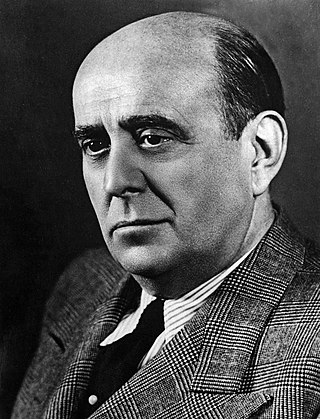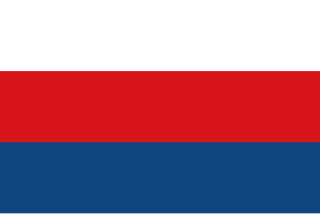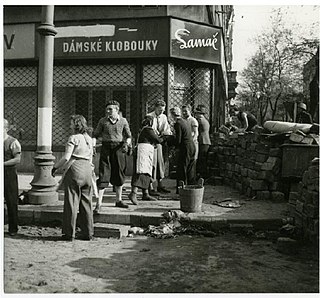Related Research Articles

The Czech Republic, also known as Czechia, is a landlocked country in Central Europe. Historically known as Bohemia, it is bordered by Austria to the south, Germany to the west, Poland to the northeast, and Slovakia to the southeast. The Czech Republic has a hilly landscape that covers an area of 78,871 square kilometers (30,452 sq mi) with a mostly temperate continental and oceanic climate. The capital and largest city is Prague; other major cities and urban areas include Brno, Ostrava, Plzeň and Liberec.

Czechoslovakia was a landlocked state in Central Europe, created in 1918, when it declared its independence from Austria-Hungary. In 1938, after the Munich Agreement, the Sudetenland became part of Nazi Germany, while the country lost further territories to Hungary and Poland. Between 1939 and 1945, the state ceased to exist, as Slovakia proclaimed its independence and Carpathian Ruthenia became part of Hungary, while the German Protectorate of Bohemia and Moravia was proclaimed in the remainder of the Czech Lands. In 1939, after the outbreak of World War II, former Czechoslovak President Edvard Beneš formed a government-in-exile and sought recognition from the Allies.

Prague is the capital and largest city of the Czech Republic and the historical capital of Bohemia. Situated on the Vltava river, Prague is home to about 1.4 million people. The city has a temperate oceanic climate, with relatively warm summers and chilly winters.

Reinhard Tristan Eugen Heydrich was a high-ranking German SS and police official during the Nazi era and a principal architect of the Holocaust.

Charles University, also known as Charles University in Prague or historically as the University of Prague, is the oldest and largest university in the Czech Republic, the second university established in the Holy Roman Empire after Bologna. It is one of the oldest universities in the world in continuous operation, the first university north of the Alps and east of Paris. Today, the university consists of 17 faculties located in Prague, Hradec Králové, and Plzeň. Charles University ranks 1st in Eastern Europe in the QS ranking, and 248 globally.

The Czechs, or the Czech people, are a West Slavic ethnic group and a nation native to the Czech Republic in Central Europe, who share a common ancestry, culture, history, and the Czech language.

Jan Garrigue Masaryk was a Czech diplomat and politician who served as the Foreign Minister of Czechoslovakia from 1940 to 1948. American journalist John Gunther described Masaryk as "a brave, honest, turbulent, and impulsive man".
The First Czechoslovak Republic emerged from the collapse of the Austro-Hungarian Empire in October 1918. The new state consisted mostly of territories inhabited by Czechs and Slovaks, but also included areas containing majority populations of other nationalities, particularly Germans (22.95 %), who accounted for more citizens than the state's second state nation of the Slovaks, Hungarians (5.47 %) and Ruthenians (3.39 %). The new state comprised the total of Bohemia whose borders did not coincide with the language border between German and Czech. Despite initially developing effective representative institutions alongside a successful economy, the deteriorating international economic situation in the 1930s gave rise to growing ethnic tensions. The dispute between the Czech and German populations, fanned by the rise of Nazism in neighbouring Germany, resulted in the loss of territory under the terms of the Munich Agreement and subsequent events in the autumn of 1938, bringing about the end of the First Republic.

The Protectorate of Bohemia and Moravia was a partially-annexed territory of Nazi Germany that was established on 16 March 1939 after the German occupation of the Czech lands. The protectorate's population was mostly ethnic Czech.

Jan Kubiš was a Czech soldier, one of a team of Czechoslovak British-trained paratroopers sent to eliminate acting Reichsprotektor (Realm-Protector) of Bohemia and Moravia, SS-Obergruppenführer Reinhard Heydrich, in 1942 as part of Operation Anthropoid. During the assassination attempt, Kubiš threw a makeshift grenade that mortally wounded Heydrich.

Karl Hermann Frank was a Sudeten German Nazi official in the Protectorate of Bohemia and Moravia prior to and during World War II. Attaining the rank of Obergruppenführer, he was in command of the Nazi police apparatus in the protectorate, including the Gestapo, the SD, and the Kripo. After the war, he was tried, convicted and executed by hanging for his role in organizing the massacres of the people of the Czech villages of Lidice and Ležáky.

The Prague uprising was a partially successful attempt by the Czech resistance movement to liberate the city of Prague from German occupation in May 1945, during the end of World War II. The preceding six years of occupation had fuelled anti-German sentiment and the rapid advance of Allied forces from the Red Army and the United States Army offered the resistance a chance of success.

Emanuel Moravec was a Czech army officer and writer who served as the collaborationist Minister of Education of the Protectorate of Bohemia and Moravia between 1942 and 1945. He was also chair of the Board of Trustees for the Education of Youth, a fascist youth organisation in the protectorate.

The Second Hungarian Republic was a parliamentary republic briefly established after the disestablishment of the Kingdom of Hungary on 1 February 1946 and was itself dissolved on 20 August 1949. It was succeeded by the Soviet-backed Hungarian People's Republic.
Vojtech Mastny is an American historian of Czech descent, professor of political science and international relations, specializing in the history of the Cold War. He has been considered one of the leading American authorities on Soviet affairs. Mastny received his Ph.D. from Columbia University and has been professor of history and international relations at Columbia, University of Illinois, Boston University and the Johns Hopkins School of Advanced International Studies, as well as professor of strategy at U.S. Naval War College, Fulbright professor at the University of Bonn, senior research scholar at the Woodrow Wilson International Center for Scholars and senior fellow at the National Security Archive. He is the coordinator of the Parallel History Project. In 1996-1998 he was the first researcher awarded Manfred Wörner Fellowship by NATO. Mastny's books include Continental Europe under Nazi Rule, which won him the Clarke F. Ansley award in 1971, Russia's Road to the Cold War (1979), The Helsinki Process and the Reintegration of Europe (1992) and The Cold War and Soviet Insecurity: The Stalin Years, which won the American Historical Association's 1997 George L. Beer Prize.

The Final Solution of the Czech Question was the Nazi German plan for the complete Germanization of the Protectorate of Bohemia and Moravia. Nazi German sociologist and anthropologist Karl Valentin Müller asserted that at least half (50%) of the Czech nation was "racially Aryan" and could be Germanized. This was in stark contrast to Germany's Final Solution to the Jewish Question, which called for the total extermination of the Jews save for a select "honorary Aryans". Müller asserted that Germanization of the Czechs could be first attempted without coercion; instead, he suggested a system of social incentives.
Censorship in the Czech Republic had been highly active until 17 November 1989 and the fall of Communism in the former Czechoslovakia. Czech Republic was ranked as the 13th most free country in the World Press Freedom Index in 2014.

Františka Plamínková was a Czech feminist and suffrage activist. Trained as a teacher, she became involved in feminism because teachers were forbidden to marry. She transitioned into journalism, writing articles about inequality. Elected to the Prague City Council and the National Assembly, she served as Senate Chair when Czechoslovakia broke away from the Austro-Hungarian Empire. She was a vice president of the International Council of Women, as well as the International Woman's Suffrage Alliance and attended many international feminist congresses. Plamínková was arrested by the Gestapo in 1942 and executed.
Prague in Black: Nazi Rule and Czech Nationalism (2007) is a book by the American historian Chad Bryant about how Czech nationalism developed in the German-occupied Protectorate of Bohemia and Moravia during World War II. It received mostly favorable reviews.
National indifference is the status of lacking a strong and consistent national identity. The concept was originated by scholars of the Bohemian lands, where many inhabitants historically resisted classification as either Czechs or Germans, around 2000. It was outlined by Tara Zahra in her 2010 paper published in Slavic Review, "Imagined Noncommunities: National Indifference as a Category of Analysis". In 2016, an academic conference was held in Prague to discuss the concept.
References
- ↑ "Chad Bryant". history.unc.edu. Retrieved 12 December 2021.
- ↑ "Chad Bryant: the complexities and contradictions of Czech nationalism under Nazi rule". Radio Prague International. 21 June 2014. Retrieved 12 December 2021.
- ↑ "Library Journal". www.libraryjournal.com. Retrieved 12 December 2021.
- ↑ "Making a home in Prague". The Economist. 27 May 2021. Retrieved 12 December 2021.
- ↑ "A city visible but unseen". www.telegraphindia.com. Retrieved 12 December 2021.
- ↑ "Five figures and their civic visions of their hometown". TLS. Retrieved 12 December 2021.
- ↑ Donert, Celia (12 March 2024). "Biographies of a Central European City". The American Historical Review. 129 (1): 233–235. doi:10.1093/ahr/rhad510.